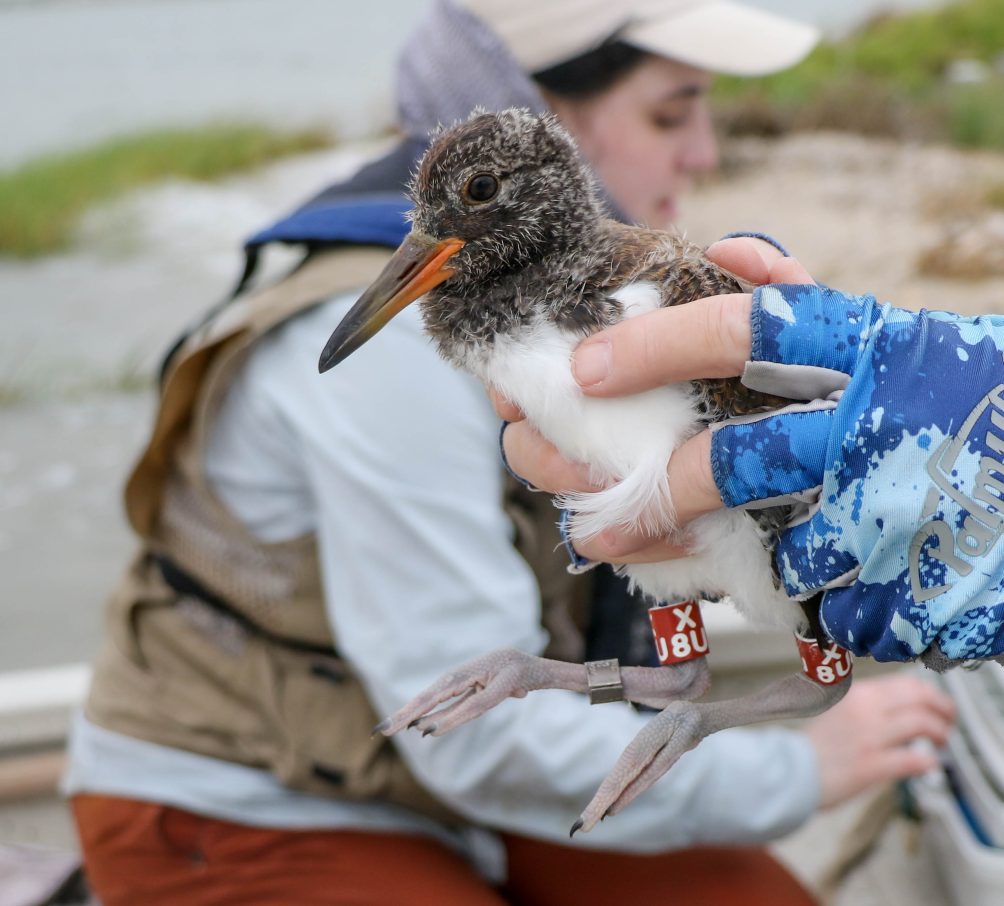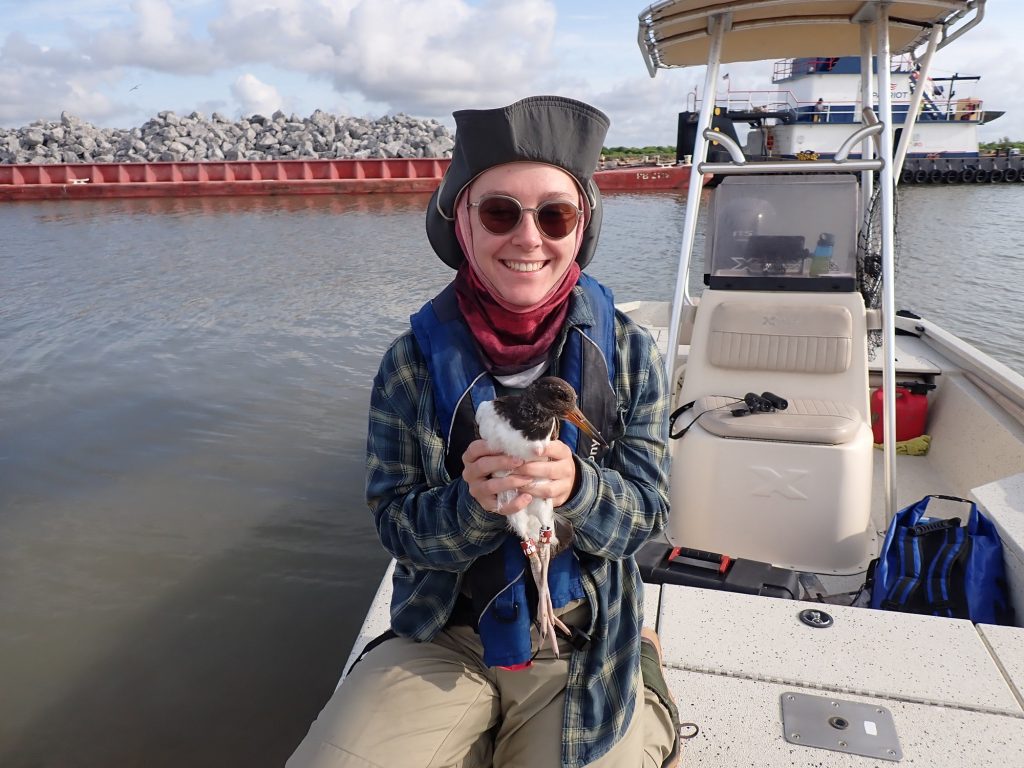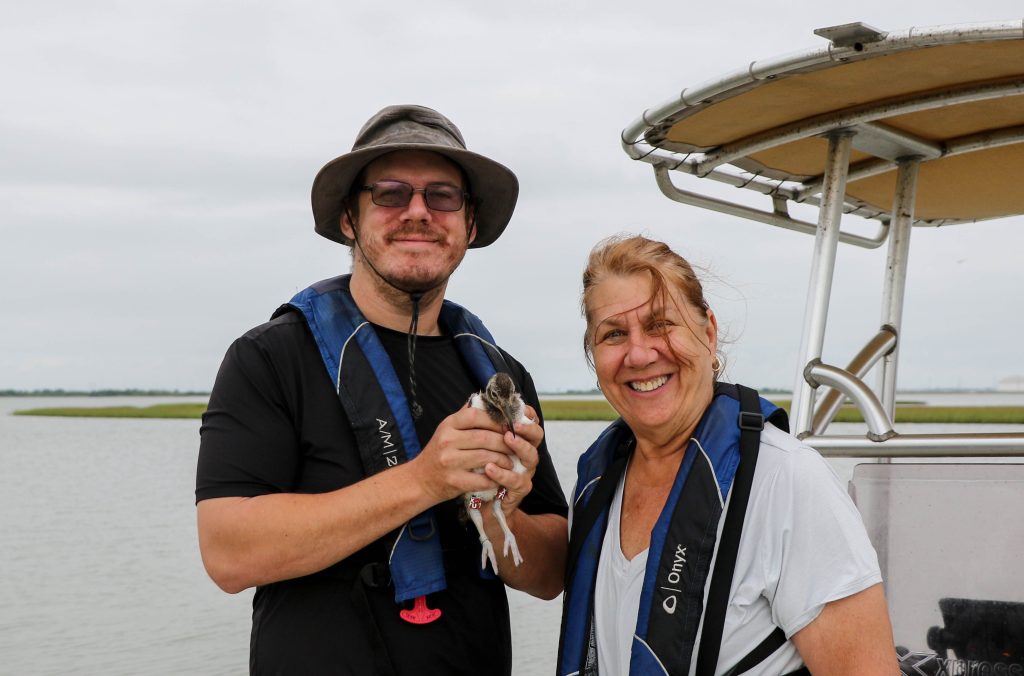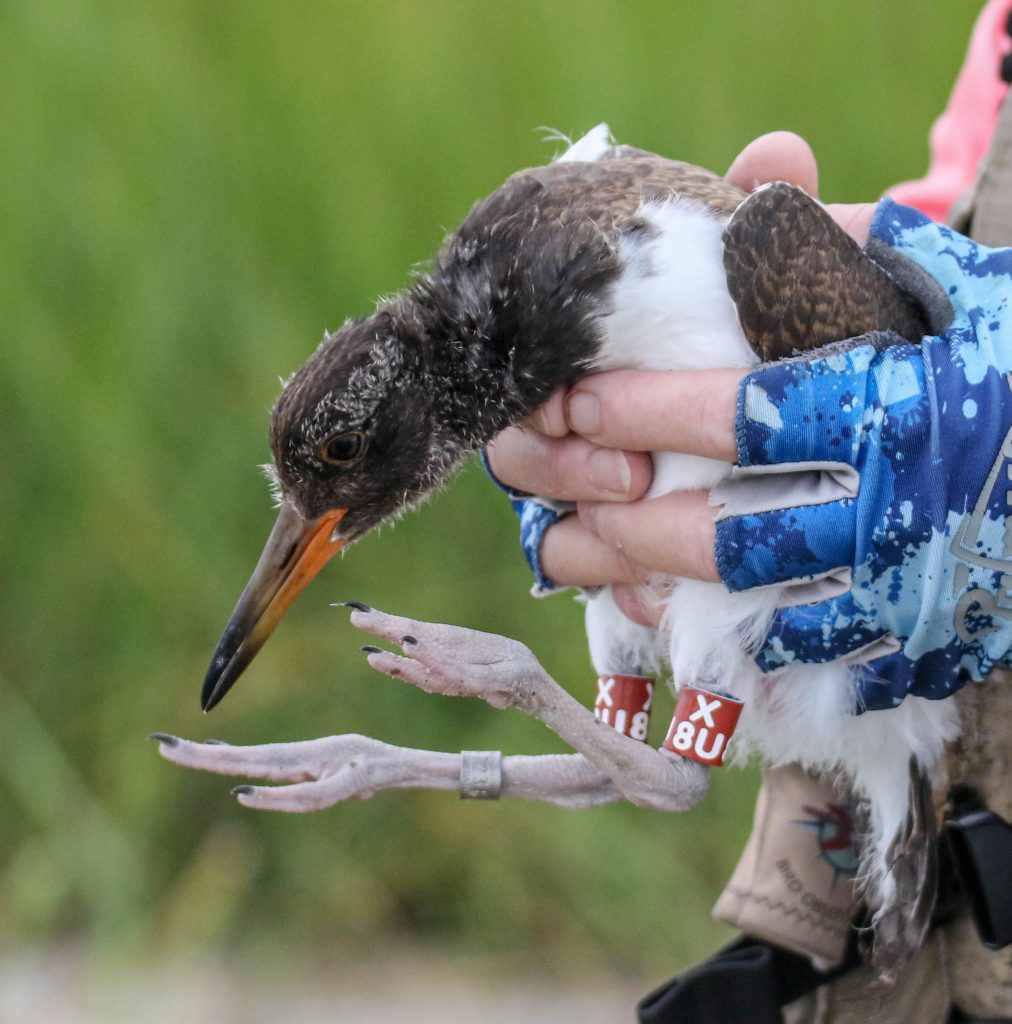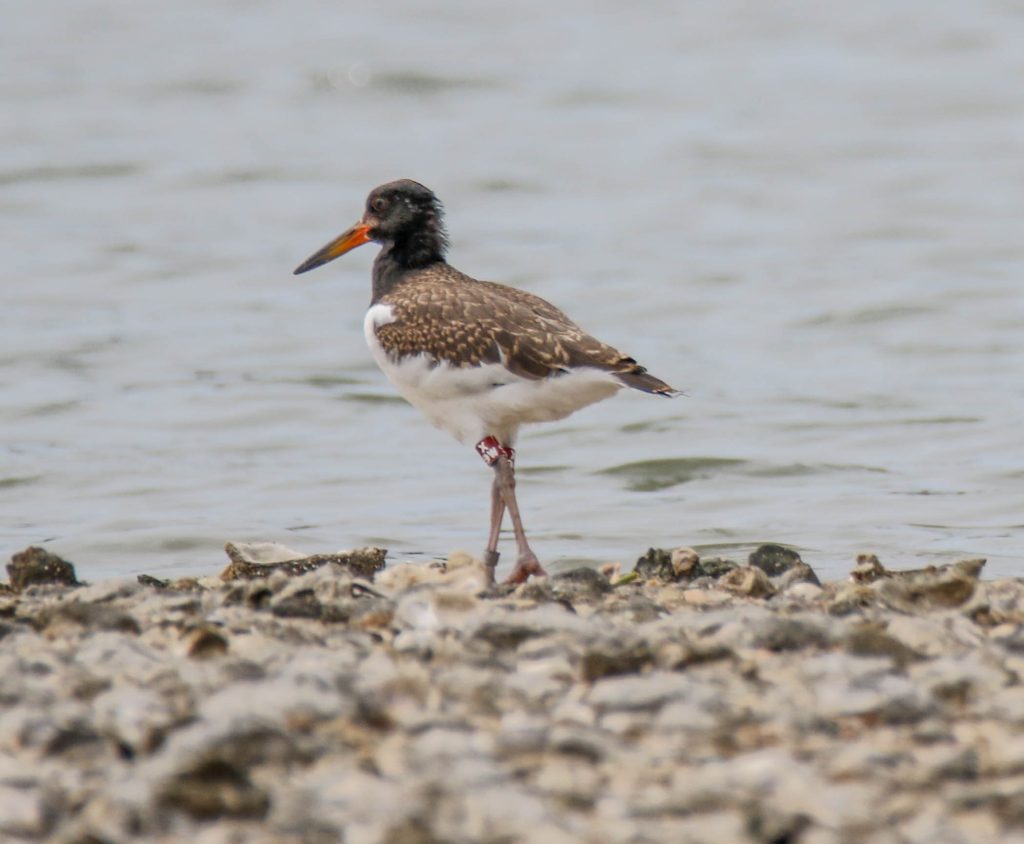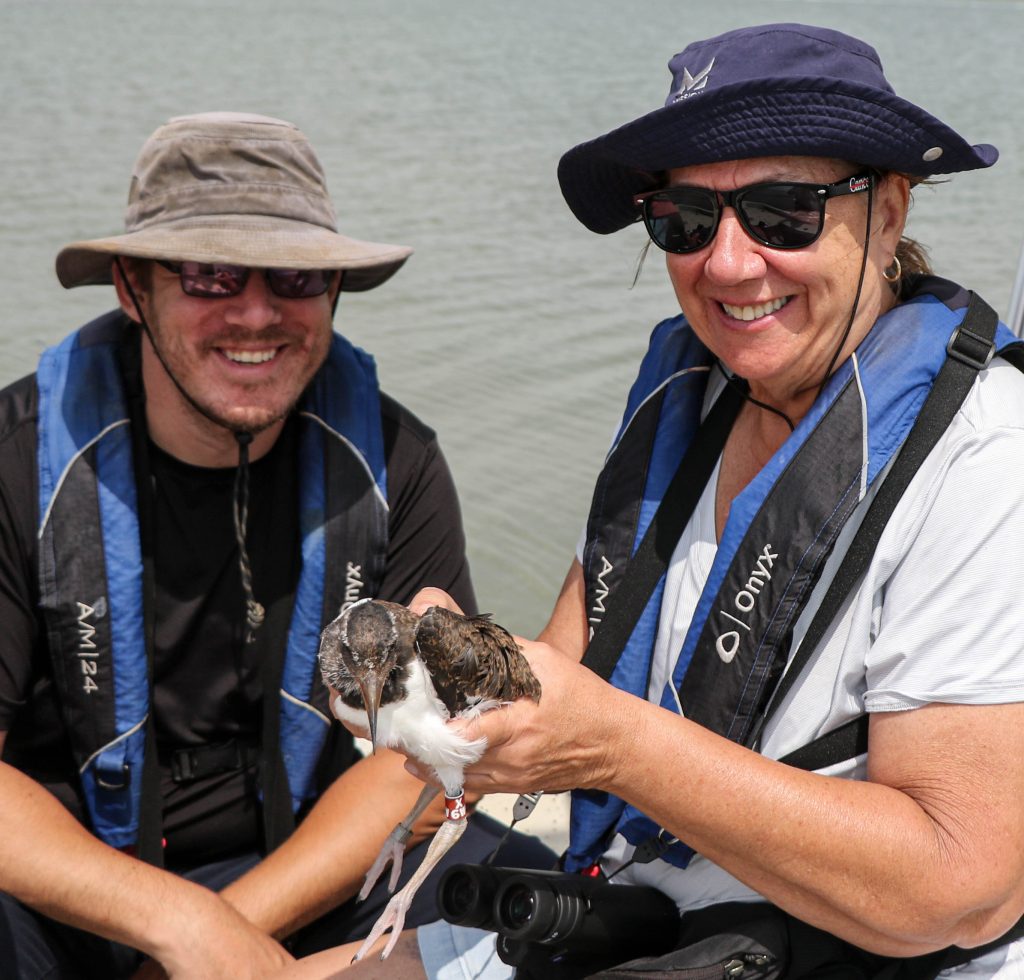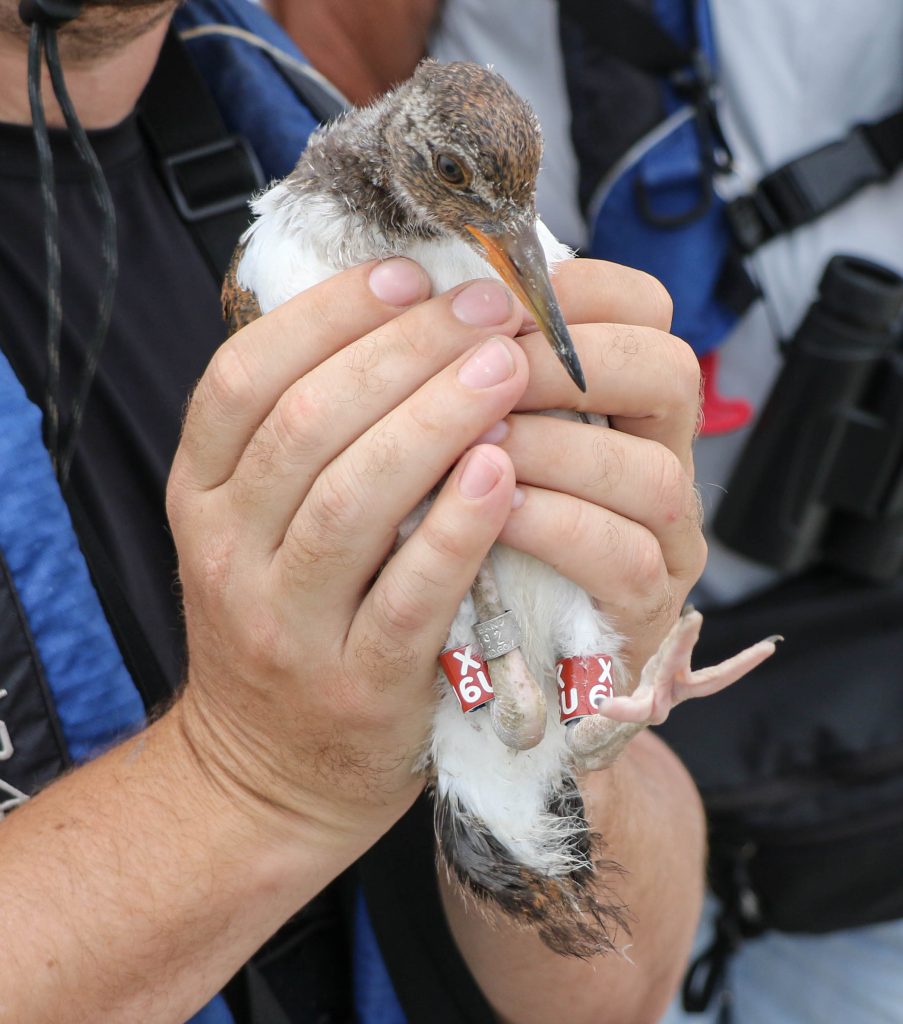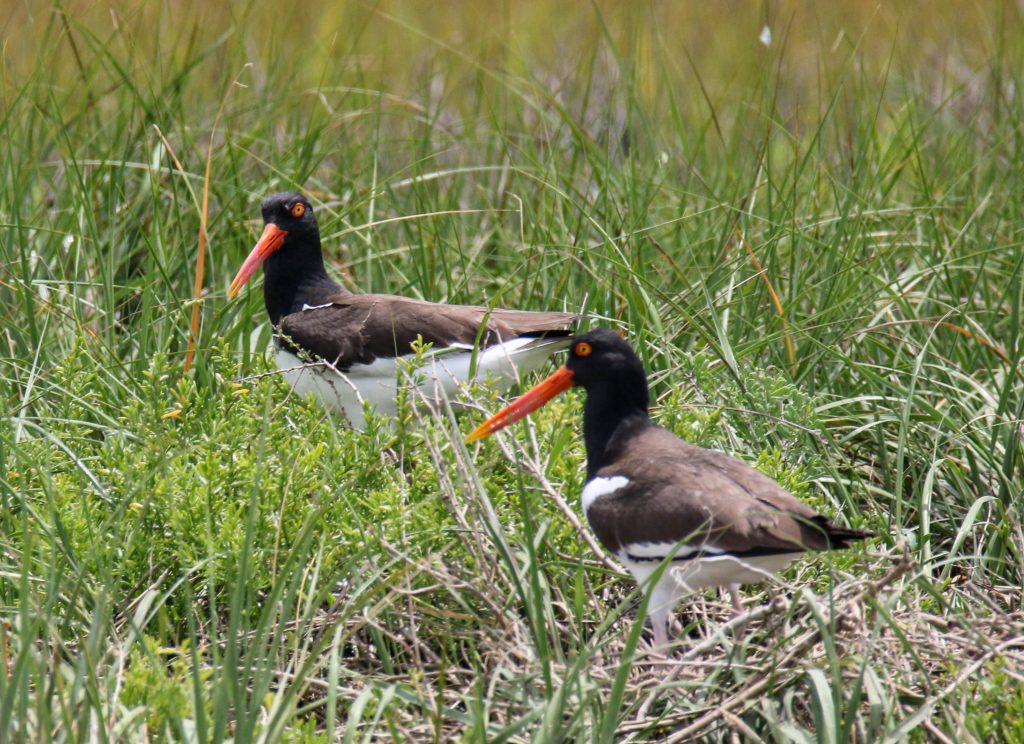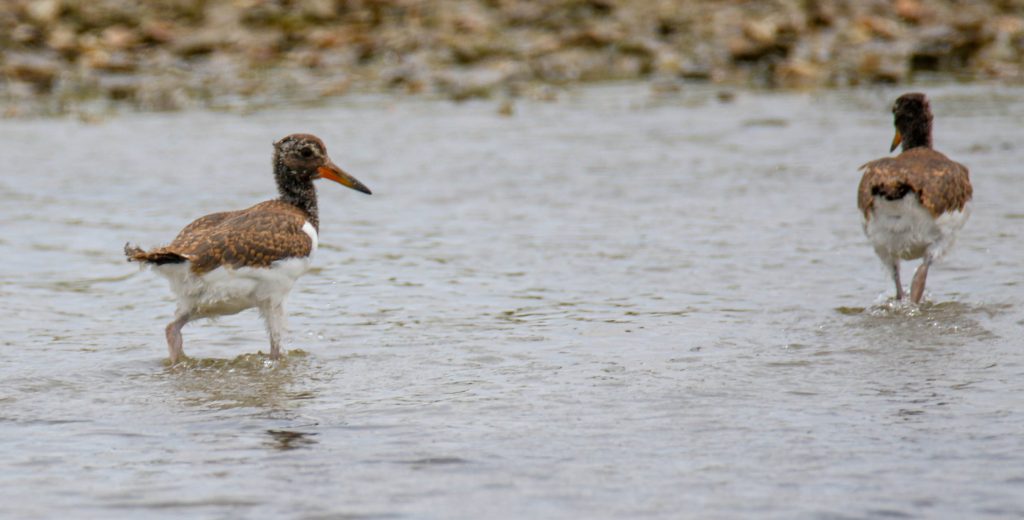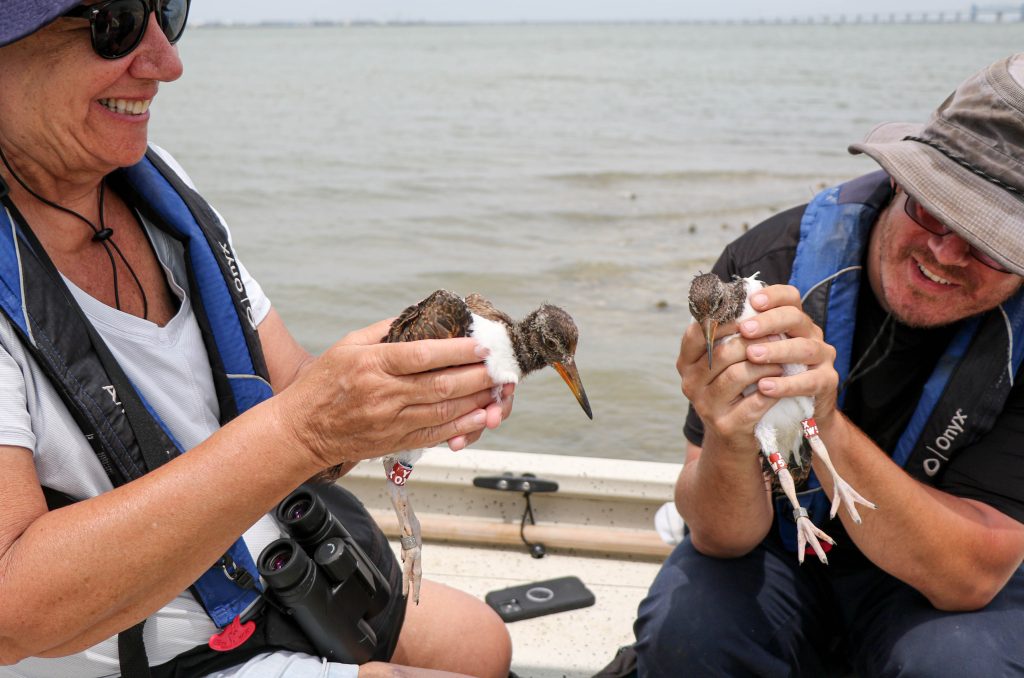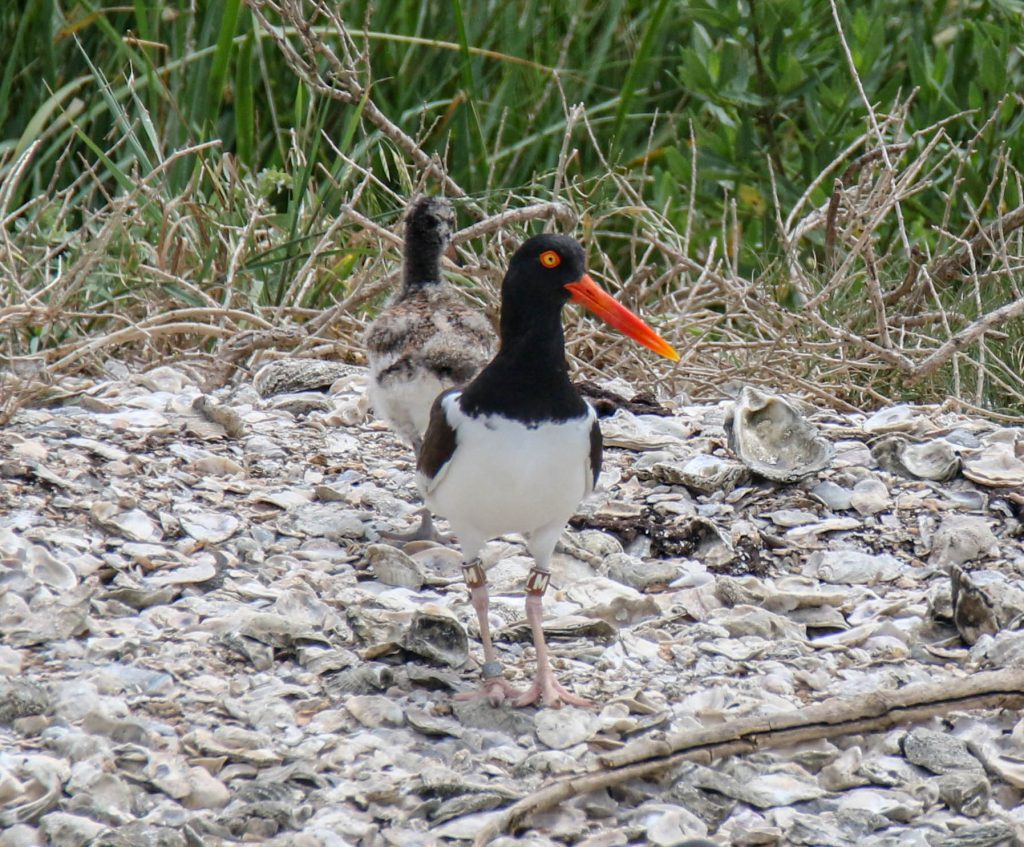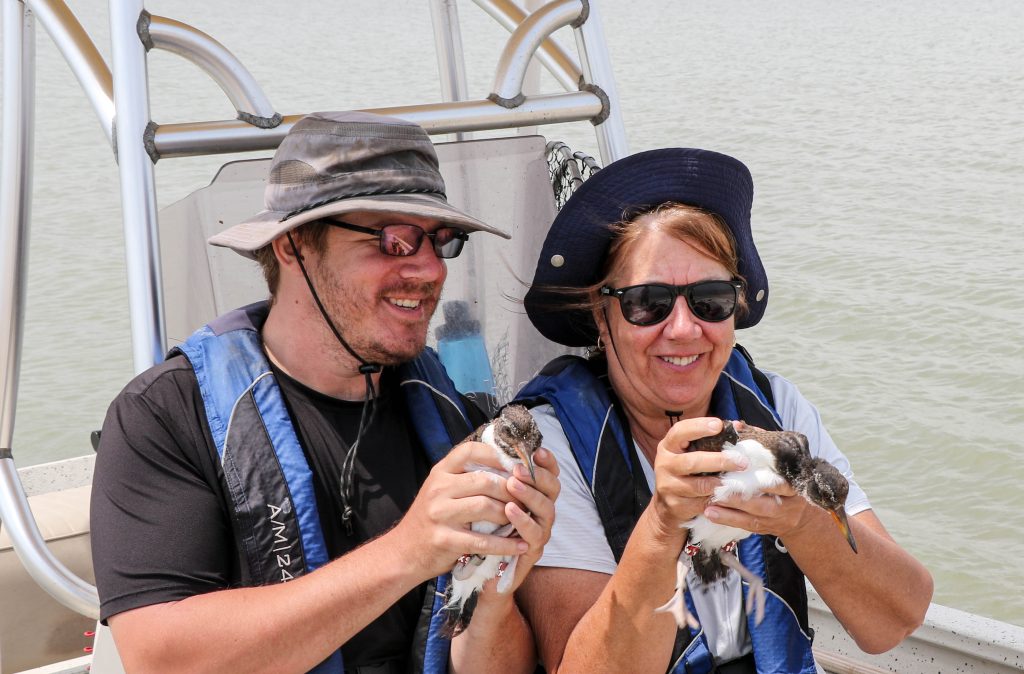By Susan Heath
On Tuesday, Taylor B, Taylor S and I headed out to check the birds in the Brazoria Bays. We went to the west end of West Galveston Bay first. The chick at the mooring facility was due to fledge. We found F1A (the male) standing alone in much the same place as he had been the last time we checked them. I figured that meant the chick wasn’t fledged yet and it was hiding nearby and I easily found it in the spartina. It doesn’t have far to go before it will be able to fly!
We checked Alligator Point Island but once again there weren’t any oystercatchers there. I guess it’s time to give up on that island. We headed into Bastrop Bay and found CH standing alone along the shoreline by the shell banks where we expected her to nest. We didn’t see her mate anywhere. It didn’t occur to me at the time that she might have been guarding a one egg nest so we didn’t check. Next time.
There weren’t any other oystercatchers in Bastrop Bay so we headed to Christmas Bay. We searched the length of the shoreline on the Gulf side of the bay checking to see if AR & unbanded had taken their chicks exploring. I was sure they were fledged so they might not be where the nest had been. Instead we found W6Y and an unbanded bird on some riprap. Hum. W6Y is a 2020 chick so its old enough to breed but where? We’ll have to keep tabs on them.
As I expected we did not see AR & unbanded or their chicks where their nest had been. Drat. We motored around to the other side of the island to check on E7A & unbanded. They were both there and had a couple new scrapes prepared. Are they going to try for a third time? Time will tell.
Taylor B spotted AR and family out on a reef very far away. We couldn’t get any closer because the tide was so low but at least we know both chicks survived and are fledged. Yay!
That was all there was to check so we headed back to the boat ramp.
On Thursday, Alan Wilde and I headed out to show our Experience Auction winners, Lori McKenna and her son Mike Brakefield all about oystercatchers. It’s always fun showing new people around out there and we had a great day! We headed up toward Swan Lake and checked on 20 & unbanded. Before we were anywhere near their nesting territory, one of them flew out to “greet” us, circled the boat and then flew back to where it had come from. I took that as a sign that they still have chicks. When we actually got to where they nested, the other adult was out on a reef getting food so all is well there.
We hadn’t gotten more than 50 yards from them when either LR or his mate came flying out to “greet” us and flew roughly alongside us the entire way back to their territory. A good sign that their chick is also fine! The other adult was on the island and they watched us closely while we were there.
We tried to spy on 11 & unbanded from there and Alan said he saw one of them where they usually nest but it was too far to tell if it was incubating or not. There was a fishing boat sitting smack dab in the middle of the channel into Swan Lake so I went down to the far entry and headed in there. Since we were pretty close to X3 & unbanded at that point, I decided to try to sneak up on them because we needed to band their chick. That worked pretty well and they erupted from the vegetation so we new where to look. Lori found the chick hiding under a bush. I think I walked right by it without noticing it!
Then we checked on all the other pairs in Swan Lake. K7 & unbanded also flew out to “greet” us so I figured their chick wasn’t quite fledged. We found it hiding right along the shoreline. Only a few more days and it will be able to fly.
I searched for a nest for 11 & unbanded but found none. They had some good scrapes prepared though so I guess they are thinking about. I managed to avoid disturbing the nesting Clapper Rail this time. It wasn’t very windy so the ride back over Galveston Bay to West Galveston Bay wasn’t too bad.
We headed to Struve. 12 & unbanded flew out and circled the boat but their chick remained on the island. Since we saw it fly last time, we left it alone. L9 & unbanded and their chick were on their island among the mass of skimmers so all was well there too. Nothing was happening with the other oystercatcher pairs there so after we were done with the skimmers we headed to Jigsaw.
As we arrived, we saw LH & JX’s chick make a run for the vegetation. It was time to band that one too so I jumped off the boat in hot pursuit. Fortunately, it didn’t go far and I found it easily.
It’s unclear what’s happening with the other two pairs there. YE & unbanded had a nest but I think it failed. They don’t seem to have a chick. X2 & W2Y have been acting sketchy for weeks but we haven’t found a nest unless they laid it by the large tern colony. I have stayed away from that area so I don’t disturb them. Disturbed nesting terns are the definition of angry birds!
Along the Galveston shoreline, we found YK & unbanded’s nest had failed as predicted. With so many mammals in that area, eggs along that shoreline just don’t stand a chance. Poor birds. They try so hard. We didn’t see 16 & W8W or any other oystercatchers at 8 Mile Road or on the docks. The tide was low so we figured they were on Confederate Reef.
C8A & unbanded were both on their tiny island where their nest had been. It was time for it to hatch but from all indications there aren’t any chicks. They could fool me though. We’ll keep watching! It was time to band A4A & unbanded’s chick also and unfortunately they were way down the shoreline on a mud bank where I can’t take the boat because the shoreline is lined with cement oyster balls intended to stave off erosion. I had to land the boat at the other end of the island and walk down to where they were to look for the chick. It was just hiding on the edge of the vegetation though. Good chick! So far so good with finding chicks this day!
From there we headed to Confederate Reef and found the gang of youngsters. 19 of them feasting away. It’s good to see them doing so well. On South Deer only one of A1A & unbanded was present when we arrived and we didn’t see the chick so I guess it isn’t fledged yet. I noticed the other adult come flying back with food in its bill so that’s a good bet it was bringing food for the chick. I searched briefly but was unable to find it so we moved on. It should be able to fly next week.
A5A & unbanded weren’t home and neither were Y7 & unbanded so the gulls must have gotten their eggs. Dang gulls!
Next it was time to band F1A & E2A’s chick. When we arrived, the entire family was out on a reef that was connected to the island because of the low tide and we saw two chicks scurrying towards the vegetation.
Two chicks! I thought they only had one. Sweet! Mike and I found them in the vegetation without too much trouble.
Then on to North Deer. E8A & unbanded weren’t home or at least we didn’t see them among the masses of gulls so I suspect if they had a chick it turned into gull food. Sad. C1A & unbanded were still incubating their three eggs though. Yay!
YM & JH were hanging out along the shoreline with only one chick. If you read last week’s blog you will remember that I wasn’t too happy with their parenting skills with two chicks. They were not protecting them from the gulls well enough and I guess only having one chick this week is the result of that. YM & JH believe in tough love I guess.
JJ & P4 were out on a reef feeding so their nest definitely failed. We did not see J6 & UF. We didn’t see them last week either. I wonder if they have snuck off to someplace odd to try to nest again. They have been known to do that. We might have to instigate a full-scale search next week.
JC was standing on the shell bank where her nest had been but the eggs were gone. It wasn’t time for it to hatch so I suspect the gulls got the eggs. Dang it! Her mate W5 wasn’t there.
Next up was FR & unbanded’s chicks. When we got there the adults were out on a reef that is connected to their territory at low tide. We didn’t see any chicks but after I circled around and entered Jones Bay we saw a chick swimming! What the heck? We didn’t even stop on the other side. Why did it swim? I herded it back to the shore with the boat and then I had to chase it down the length of the island. I’m too old for this! When I finally caught up to it, it did the predictable and jumped in the water and dove. I was ready with the dip net though and scooped it up before it could get out to deep water. Phew. I thought maybe something had happened to the other chick because I didn’t think the adults would leave a chick alone on the island while the rest of the family was out on a reef, but Alan, faithful as ever, went looking and found the other chick hiding. Thank you Alan! It figures that it would be Fred’s chicks that would cause the biggest problems of the day!
We checked on CA & Y2. Alan had looked from afar while I was banding FR & unbanded’s chicks and saw one of them on the island so I figured they still had a chick. When we motored over there, they both landed on a reef nearby watching us. I gave a brief chick search but didn’t find it. Lots of places to hide though so I’m sure it’s there somewhere.
What a day. We banded seven chicks! I’ve never banded that many in one day before. I was beat and glad to get back to the boat ramp. I think Lori and Mike had a great time!
If you like oystercatchers and you want to support this project, you can make a donation (thank you!) on our website here. And how could anyone not like oystercatchers!
Current Stats for upper Texas coast from Dickinson Bay to East Matagorda Bay: 1 nests being incubated, 20 failed nests, 13 nests with unfledged chicks, 0 nests with undetermined status, 2 chicks fledged
Note: All trapping and banding for this project is in accordance with federal and state permits issued to Susan Heath, GCBO Director of Conservation Research. Bird handling by volunteers is only permitted in the presence of Susan Heath and volunteers are trained in proper bird handling techniques.

